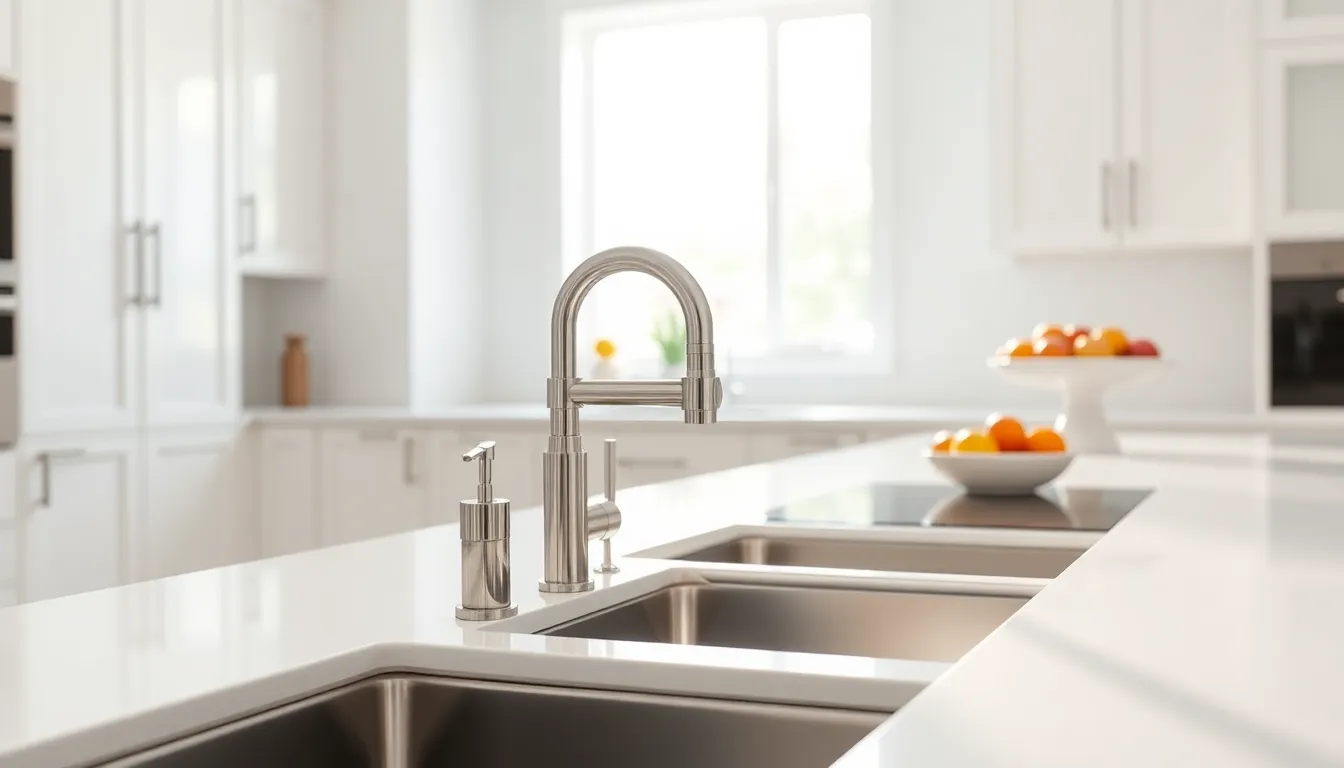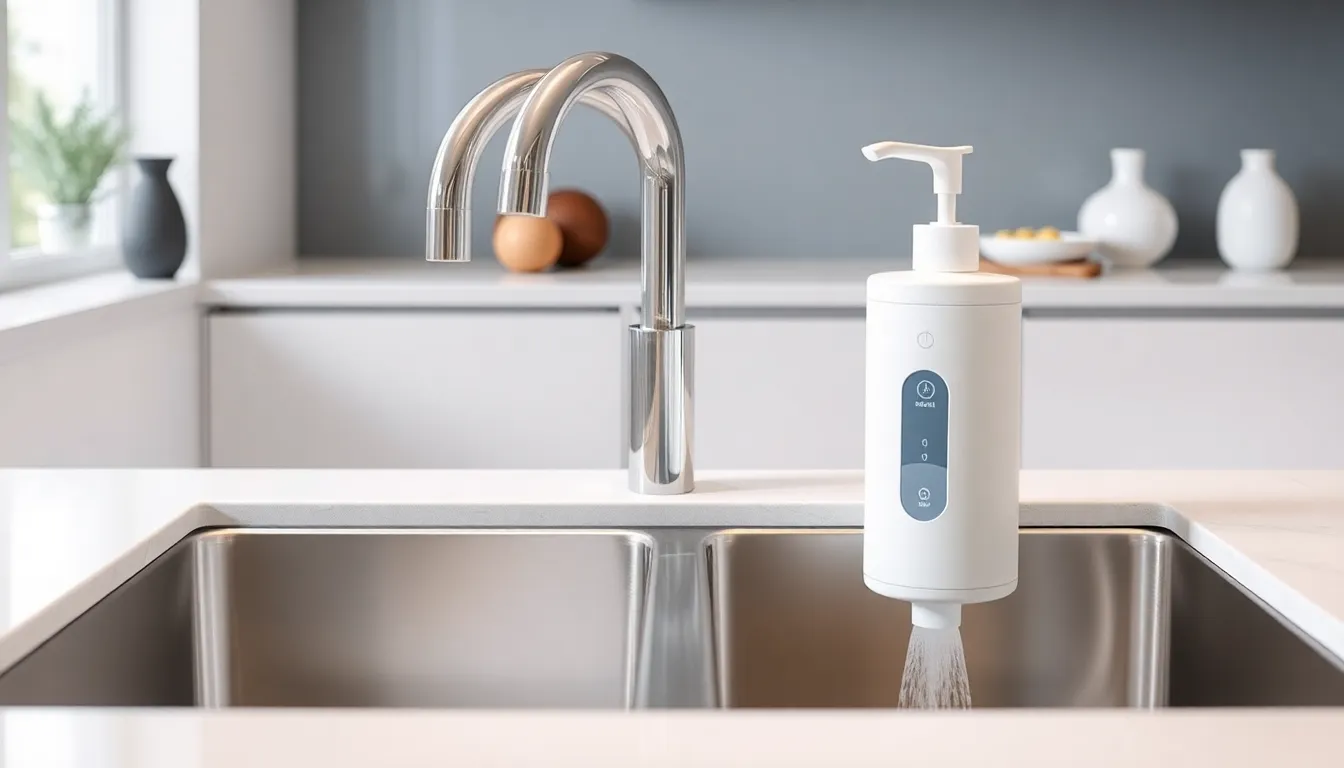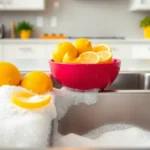
When the kitchen sink’s soap dispenser starts to resemble a sad, empty shell of its former self, it’s time for a change. No one wants to wrestle with a stubborn pump that only dispenses soap when it feels like it. A new soap dispenser can not only bring back the joy of sudsy handwashing but also elevate the entire kitchen aesthetic.
Soap Dispenser For Kitchen Sink Replacement
Replacing a worn-out soap dispenser enhances kitchen function. A reliable dispenser ensures easy access to soap, promoting effective handwashing. Kitchen cleanliness improves with a functional dispenser, reducing the spread of germs.
An attractive soap dispenser adds to the kitchen’s aesthetic. Various designs and finishes complement different decor styles. Upgrading a dispenser can transform the appearance of the sink area.
Kitchen tasks become more efficient with a properly functioning soap dispenser. Busy households benefit from quick pump action, saving time during meal prep and cleanup. Eliminating the hassle of a faulty pump encourages regular handwashing.
Durability matters while choosing a soap dispenser. Sturdy materials withstand daily use and resist wear, providing long-term value. Investing in a quality dispenser decreases the need for future replacements.
Hygiene plays a significant role in the importance of a soap dispenser. Ensuring a clean and accessible soap supply promotes health and wellness. Regular dispenser maintenance guarantees effective hygiene practices.
Opting for a new soap dispenser aligns with modern kitchen standards. Incorporating convenient features like refillable options supports sustainability. Adopting a functional dispenser reflects an organized kitchen environment.
Types Of Soap Dispensers

Soap dispensers come in various types, each designed to enhance functionality and convenience in the kitchen. Understanding these options helps in selecting the best fit for individual preferences and kitchen layouts.
Manual Soap Dispensers
Manual soap dispensers require a simple push or pull action to dispense soap. They often feature a pump mechanism, which allows users to control the amount of soap dispensed. Many designs focus on easy refill capabilities, ensuring minimal hassle during maintenance. Materials like stainless steel and plastic prevent rust and corrosion, providing durability. These dispensers typically present a classic aesthetic that can blend with various kitchen styles. Users often appreciate the straightforward operation of manual dispensers, making them an enduring kitchen staple.
Automatic Soap Dispensers
Automatic soap dispensers use sensors to detect hands and dispense soap without physical contact. This feature promotes hygiene by minimizing germ transmission, making it especially appealing in busy kitchens. Battery-operated or rechargeable options offer flexibility in placement without worrying about cord length. Various designs support different soap types, including liquid or foam formulations. Users find that the convenience of touchless operation adds a modern touch to their kitchen decor. Additionally, adjustable settings allow for customization of soap volume, enhancing the overall user experience in handwashing.
Features To Consider When Replacing
Choosing a new soap dispenser involves several key features that can impact functionality and aesthetics. The following aspects warrant consideration.
Size And Capacity
Size significantly influences soap dispenser efficiency. A smaller dispenser fits snugly near the sink, facilitating easy access without wasting counter space. Larger models hold more soap, reducing the need for frequent refills. Assessing family or household habits helps determine the ideal capacity. Dispensers with 8 to 16-ounce capacities accommodate typical usage patterns effectively. Additionally, ensuring compatibility with kitchen design enhances usability.
Material And Durability
Durable materials contribute to the lifespan of a soap dispenser. Stainless steel presents a sleek, resilient choice that withstands daily wear and tear. Plastic options offer lightweight usability at an economical price, but check for high-quality plastic to ensure longevity. Glass dispensers provide elegance and often complement modern decor, although they require careful handling. Each material option delivers unique advantages depending on kitchen conditions and personal preferences.
Design And Aesthetics
Design plays a vital role in integrating a soap dispenser with the overall kitchen theme. Selecting a dispenser that matches existing fixtures creates a cohesive look. Consider color, finish, and form when assessing aesthetics—matte, polished, or textured surfaces present various choices. Unique designs, such as minimalist styles or decorative patterns, can enhance visual appeal. Opting for a dispenser that reflects personal taste contributes to a well-designed kitchen environment.
Installation Process
Installing a new soap dispenser enhances kitchen functionality. Follow these steps for a smooth installation.
Required Tools
Gather essential tools before starting the replacement. You’ll need a screwdriver, a wrench, and a measuring tape. A level helps ensure proper alignment of the dispenser. Additionally, having a cloth on hand assists in cleaning up any spills during the process.
Step-By-Step Guide
Begin by turning off the water supply to avoid any leaks. Remove the old dispenser using a screwdriver to detach it from the sink. Clean the area where the old dispenser was located. Next, measure the opening to ensure the new dispenser fits properly. Insert the new soap dispenser into the opening, tightening the securing nut with a wrench. After that, align it using a level to maintain a straight appearance. Finally, connect the soap tube to the dispenser, refill it with soap, and turn the water supply back on. Test the dispenser to ensure it’s functioning correctly, ensuring a hassle-free handwashing experience.
Maintenance Tips For Longevity
Keep the soap dispenser clean to ensure it operates smoothly. A simple mixture of warm water and mild dish soap works effectively for this purpose. Wipe down the exterior regularly to remove soap residue and prevent buildup.
Check the pump mechanism every few weeks. Regular checks allow early detection of any issues, ensuring consistent soap flow. If any clog forms, clear it promptly to avoid frustrating handwashing experiences.
Replace the soap periodically, ensuring it fits the dispenser’s type specifications. Sticking to liquid soap for manual dispensers and appropriate refills for automatic options helps maintain functionality.
Inspect the dispenser for any signs of wear and tear. Cracks or leaks indicate the need for replacement. Addressing these issues sooner rather than later prevents additional damage to surrounding areas.
Ensure proper installation remains intact. Loose fittings can lead to leaks and complications in performance. Tightening screws or connections can extend the lifespan of the dispenser.
Consider the environment where the dispenser sits. Exposure to extreme temperatures or humidity may affect its durability. Utilize a spot away from direct sunlight to prevent material degradation.
Evaluate the need for occasional deep cleaning. Disassembling the dispenser allows thorough cleaning of the pump and internal components, ensuring hygiene and effectiveness. Following the manufacturer’s guidelines for cleaning frequencies enhances longevity.
Investing time in maintenance significantly extends the soap dispenser’s life. Adopting these habits not only promotes a clean kitchen but also contributes to overall health and efficiency.
Conclusion
Replacing a kitchen sink soap dispenser is a simple yet impactful upgrade that can significantly enhance both functionality and aesthetics. A well-chosen dispenser not only streamlines handwashing but also contributes to a cleaner and more organized kitchen environment. With options ranging from manual to automatic dispensers, there’s a perfect fit for every household’s needs.
Proper installation and maintenance are key to ensuring longevity and optimal performance. By investing in a durable and stylish soap dispenser, individuals can promote hygiene and efficiency in their kitchens. Ultimately, this small change can lead to a more enjoyable cooking and cleaning experience, making it a worthwhile consideration for any kitchen makeover.



